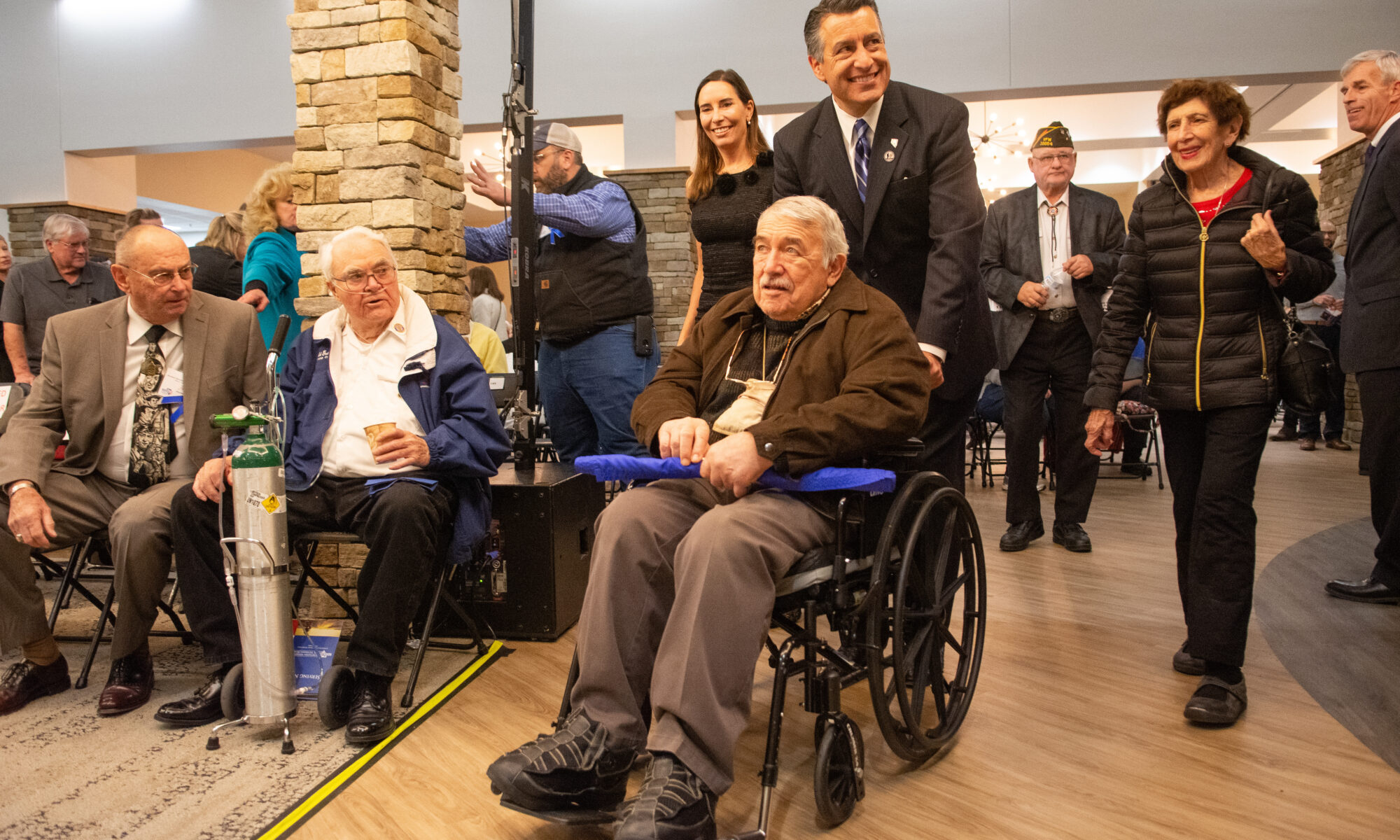
First of a five-part series examining outgoing Gov. Brian Sandoval's legacy in politics, health care, economic development, education and the environment.
On a cold Monday evening in December, a crowd had piled into the small chapel at the nearly finished Northern Nevada Veterans Home in Sparks, looking on as a cloth was whisked away from a bronze plaque on the entryway wall.
Eighty-year-old Ron Sandoval, in a wheelchair, gazed up at the sepia-toned image of him as a young airman in the 1950s. The inscription honors his four years of military service during the Cold War. But it also honors the eight years of civilian service of the man who clutched the handles of his wheelchair and pushed him through the building — his son, a non-veteran who had set a goal of making his state the most veteran-friendly in the country.
“We are grateful that Ron’s legacy served as an inspiration to Governor Brian Sandoval, who made honoring and supporting Nevada’s veterans and their families a key tenet of his administration,” the placard reads.
For the younger Sandoval, cutting the ribbon on a 96-bed nursing home that will accommodate servicemembers and Gold Star families in their final years, and doing it with his own family looking on, put a literal and figurative bow on his two terms in office and a public service career spanning three decades and every branch of government. It was a project that likely would still be stalled in the purgatory of a federal funding waitlist had he not led an effort to front tens of millions of dollars in state money for it.
He leaves office as one of the most popular governors in the country, having charmed many in the opposing party even as he confounded fellow Republicans, and with a list of accomplishments nearly as tangible as the veterans home: a new tax on large businesses, a long list of initiatives to boost public education, an expansion of Medicaid and tax abatements to lure billions of dollars of business investment to the state.
In 2010, a political cartoonist drew Sandoval as a broadly smiling, perfectly coiffed knight on a white horse, with then-Republican Gov. Jim Gibbons and his tumultuous term looking small and vanquished in the background. Observers wondered aloud whether Nevada’s first Hispanic chief executive would be the new face of the Republican Party in an increasingly diverse country.
Eight years later, his place in a national and state Republican pantheon is more uncertain than ever, given his coldness toward President Donald Trump and a Democratic wave in Nevada in 2018. His perceived ambivalence to party politics and his seemingly loose grip on some of its credos has irked some fellow Republicans who don’t think he’s maximized his perch to develop and elevate the party.
To hear him exhort state employees at a recent Board of Examiners meeting about how public service is a gift and how great it is to have a job where you can make a difference in someone’s life every day, though, it seems that being a GOP standard-bearer is of secondary or tertiary concern.
“There is a difference between wanting to do something and wanting to be something,” Sandoval said in an interview with The Nevada Independent. “And a lot of times I hear people who either want to get into politics or are in politics, is ‘I want to be a senator, and I want to be a governor, and I want to be an assemblyman.’ And my next question is, ‘That’s fine, but what do you want to do? What difference are you going to make? If you’re lucky enough to be in public service, are blessed enough, when you look back, what are you going to look back and be proud of? That you made a difference in people’s lives?’ That’s what’s important, not that you have a title.”
Those who work closely with him say his practicality, optimism and steady hand came at a strategic point in the state’s history, helping guide Nevada out of its downward spiral to a far healthier course.
“He established a place and a position where he was very well regarded, very well liked and very well respected across the political spectrum, and that’s not very easy these days,“ said Billy Vassiliadis, a longtime lobbyist and Democratic campaign consultant. “The intangible would be I think he established himself as unquestionably the leader of this state.”
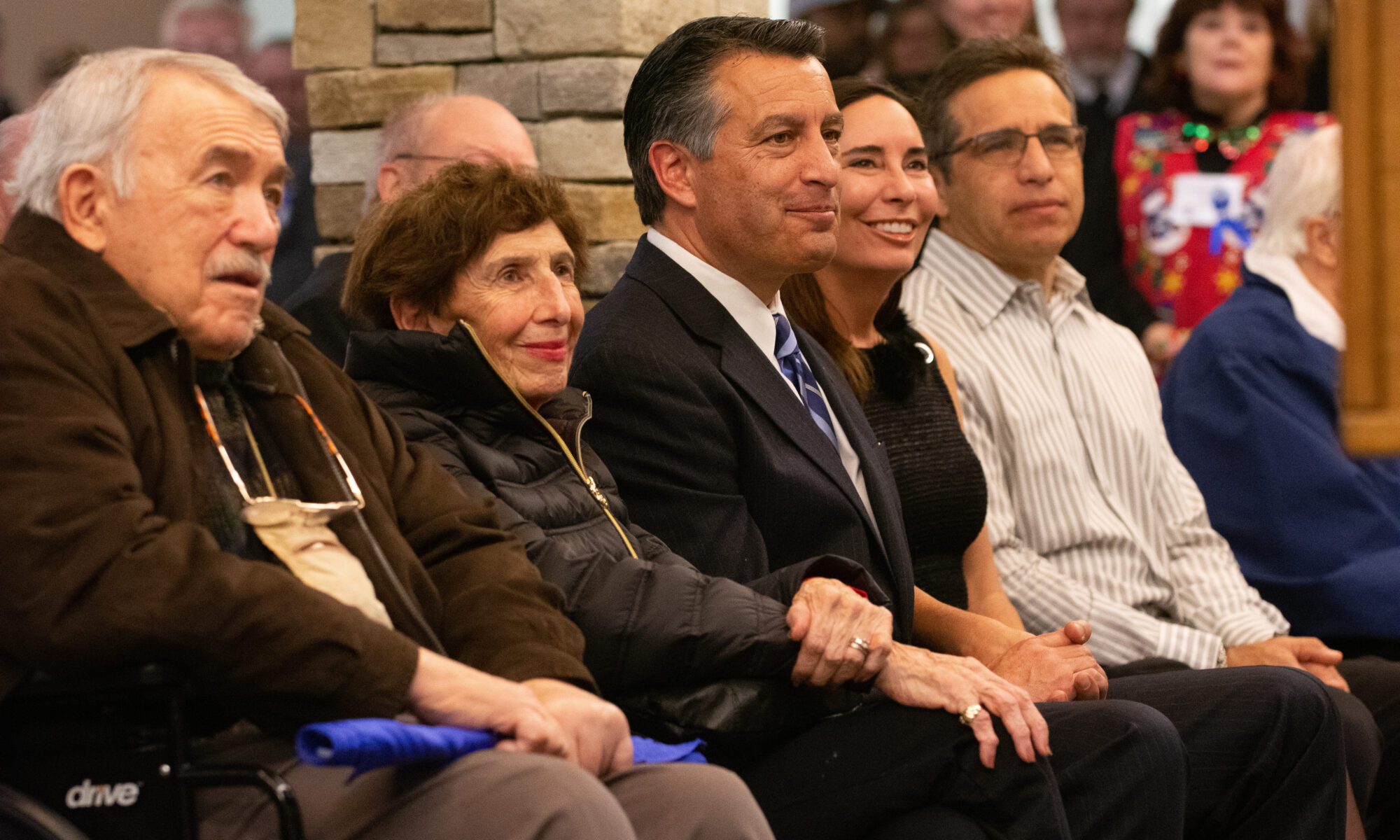
Early years
If Sandoval was a type growing up, it was “goodie two shoes,” according to Dale Erquiaga, who befriended the future governor when Sandoval moved from Southern California to Fallon. Both Catholic, they took first communion together and were well-liked by the nuns (Sandoval would later cook for nuns at a Reno hospital to help pay for college).
Sandoval was different — a Latino in the mostly ethnically homogenous community 60 miles east of Reno, wearing bell bottoms in a town known for cowboy hats.
“I was shy and awkward as a child and was my own brand of different,” said Erquiaga, who later became Sandoval’s education czar. “We were both maybe different from other kids and both pretty serious about books and school and following the rules.”
Sandoval “always wanted to do the right thing, go by the book,” said Lauri Sandoval, the governor’s older sister. “From when he was little all the way on up, he wanted to be a leader.”
With his father working as a maintenance supervisor with the Federal Aviation Administration, the family moved frequently. They eventually ended up in Sparks, which allowed the children to enroll in Little Flower School in their younger years and then attend Bishop Manogue Catholic High School in Reno.
“We were … not quite middle class. We had a government salary, not a lot,” said his brother Ron Sandoval. “But still, [my dad] and my mom together allowed us and scrimped so we could go to what they thought was going to be a better education.”
At Bishop Manogue, Sandoval was involved in a variety of activities and was in student government all four years, culminating as student body president his senior year. Heidi Gansert, his classmate, student body vice president and future chief of staff, remembers him as warm and thoughtful and as often speaking in front of rallies or for the daily morning announcements.
There were no lawyers in Sandoval’s family, but the future governor had early exposure to politics and the law because the office where his mother Gloria Gallegos worked as a legal secretary for a U.S. attorney was next to the office of then-Sen. Howard Cannon. In junior high, he was a busboy at the building’s cafeteria, cleaning up after lawyers and judges and occasionally stopping in to watch a court hearing.
While he had his sights set on the University of Utah for college — he had briefly lived in Salt Lake City as a child — he opted for the University of Nevada, Reno because it was less expensive, and he chose English as a major because he aspired to go to law school one day.
It was in college in 1984 that he met one of his mentors — U.S. Sen. Paul Laxalt, who was then at the apex of his career and known as President Ronald Reagan’s best friend. Sandoval applied cold to be his intern on Capitol Hill and got the job.
“Our family didn’t know Paul Laxalt,” Sandoval told the Territorial Enterprise in a 2015 interview. “He told me later the reason he chose me was because I raised sheep and that was his family’s background too.”
Sandoval and his brother participated in 4-H as children, raising a flock of sheep that numbered eight or nine after lambing season. Laxalt, meanwhile, was descended from Basque sheepherders who tended flocks in Northern Nevada.
After his older brother Ron headed to Ohio State University for veterinary school, Sandoval followed suit and enrolled in Ohio’s law school — largely because the application fee was only $10 and the cost was a fraction of what it was at other schools where he was accepted.
He married Kathleen Teipner — whom he met at a summer school session at UNR — in 1990, after he finished law school. They went on to have three children.
His childhood tendencies to play by the rules still come out today. Campaign manager Jeremy Hughes described a time during a stop at a crowded Basque restaurant in Elko when a table host didn’t recognize the governor and told him there would be a 90-minute wait. Even when the host was told he was dealing with the governor, Sandoval insisted he wait his turn in the queue.
“That's the one thing I think that I'm the most proud of, is he's still the same guy that he once was 50 years ago when we were little kids,” brother Ron Sandoval said. “Brian stayed true to himself all these years in politics.”
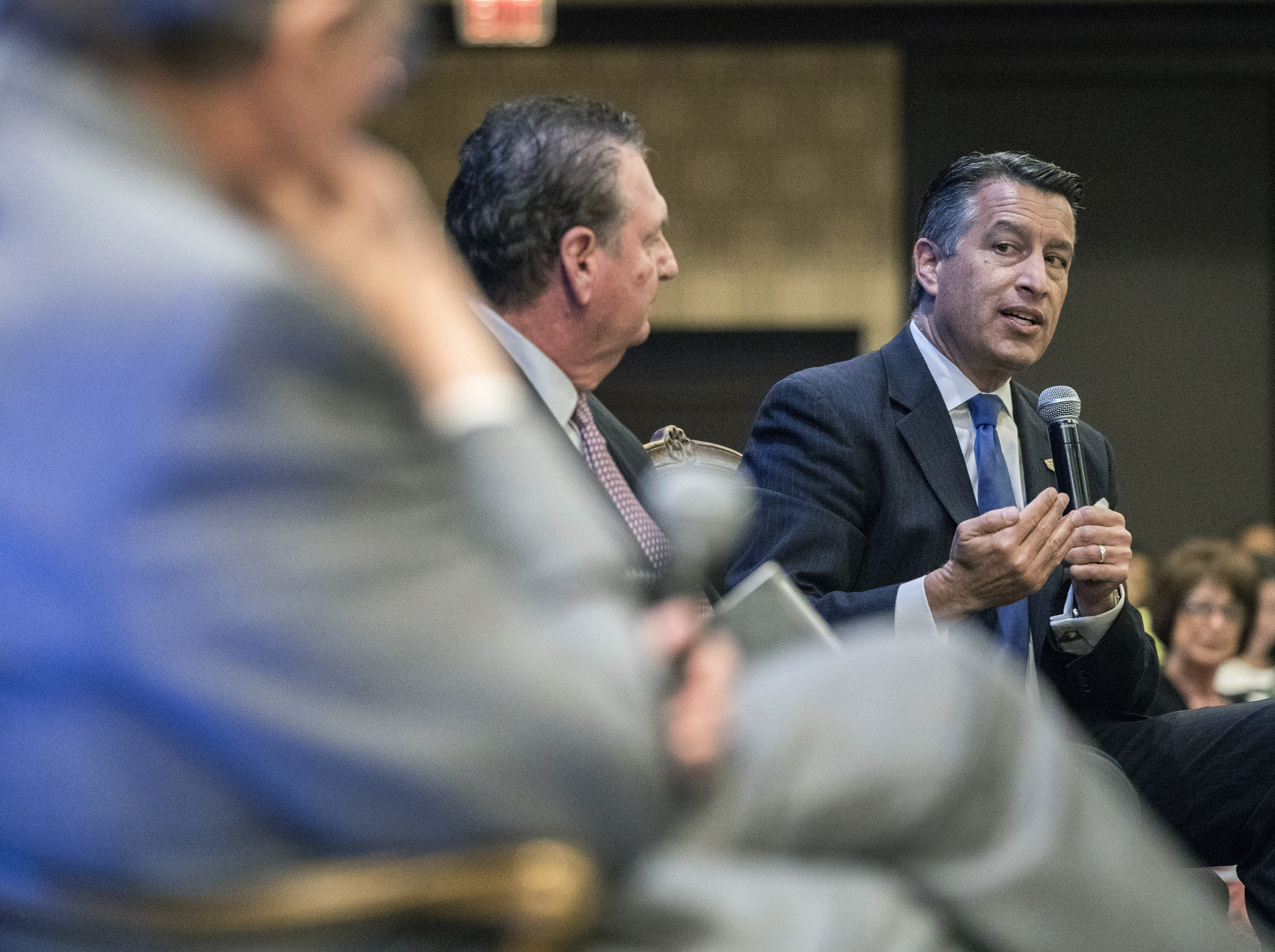
Political beginnings
It was happenstance that Sandoval purchased his first home in 1993 in the Reno Assembly district held by conservative lawmaker Jim Gibbons, who was leaving the seat to make what would be an unsuccessful run for governor.
A friend who was closely involved in Republican politics invited him to attend interviews for candidates seeking to replace Gibbons, and Sandoval later told the Territorial Enterprise that as he listened in, he thought “I could do this. I know as much as these people do.”
The party ended up backing another candidate and discouraged the 30-year-old lawyer from jumping in. But after consulting with his wife Kathleen, Sandoval decided to go for it.
He said he personally knocked on about 15,000 doors, prioritizing them by turnout in the last cycle and visiting each one twice. He gave out his phone number and invited the residents to call him if they had any questions.
If he missed a voter at the door, he’d jot down a note on his campaign literature and compliment something he noticed — the dog or the flowers in the yard, he told the Territorial Enterprise. At the end of the day, he would write a handwritten postcard addressed to each house he visited that day, mentioning something they talked about if they had opened the door. He’d drop them off at the post office so they’d have a postcard the following day.
There were also the signs. While many of his newfound supporters had placed one in their yard (he says the sheer number had people in the district calling it “Sandovaland”), he wanted to make them stand out from the other signs.
He and his wife put hundreds of inflated balloons on strings in their garage. The night before the election, they drove the district with their cars brimming with balloons, tying one to every sign in the middle of the night.
When they finally finished, the sun was coming up. By the time the sun went down, Sandoval had won the race by a landslide.
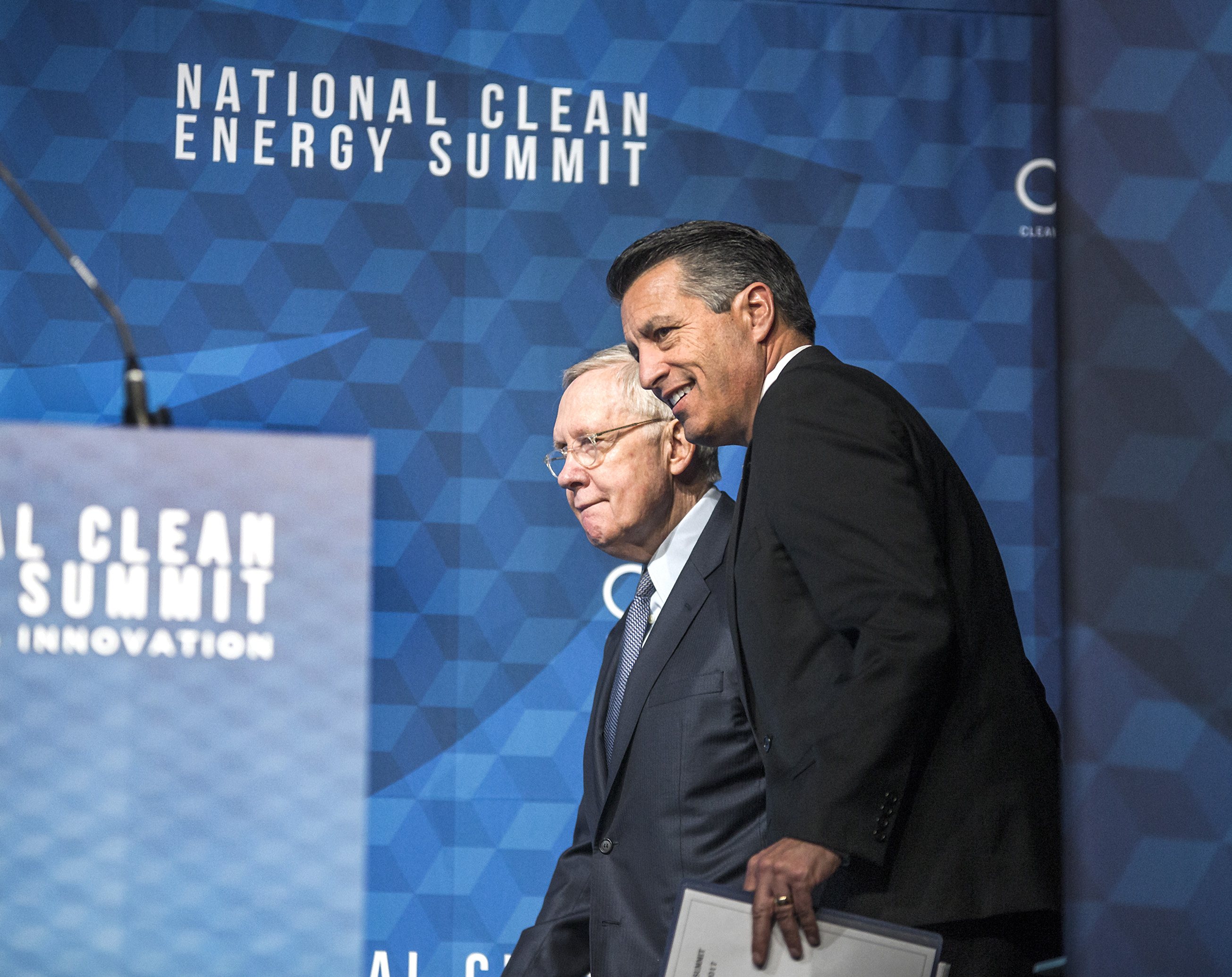
Scaling a political ladder
From there, Sandoval spent the next decade quickly advancing from one prestigious role to the next. He spent two terms in the Assembly, sponsoring bills that included preventing felons from suing victims during the commission of a crime, increasing penalties for boating under the influence and allowing indigent defendants to perform community service in lieu of paying for legal expenses.
Then, at age 35, he was appointed chair of the Nevada Gaming Commission — the youngest person to ever hold the position. He said he had to spend a lot of time in Las Vegas, away from his family, to do the job — living in a humble apartment near the Orleans with a bean bag chair, a card table and a mattress on the floor.
His work included developing regulations preventing child-friendly imagery on slot machines, fighting federal efforts to block gambling on college sport events and pushing rules limiting neighborhood gaming.
In 2001, the 38-year-old Sandoval announced he would run for state attorney general to replace termed-out Democrat Frankie Sue Del Papa. Sandoval told the Las Vegas Review-Journal in 2001 that he was running to “protect and defend the health, safety and welfare of the people of Nevada.” His candidacy was boosted by endorsements from Gov. Kenny Guinn, U.S. Sen. John Ensign and Gibbons, and gaming companies flocked to support the former industry regulator, contributing more than $400,000 to his campaign.
Erquiaga was his debate coach, and he used that skill extensively. Sandoval recalled he debated his Democratic opponent, Las Vegas attorney John Hunt, 16 times during the race before eventually winning by nearly 25 percentage points.
His relatively brief tenure as attorney general included setting up a “Public Integrity Unit” designed to investigate and prosecute misbehavior or illegal actions by public figures and continuing the state’s longstanding fight against the federal government’s attempts to store nuclear waste at the Yucca Mountain repository.
His tenure was not without some controversy, including the ouster of former state consumer advocate Timothy Hay, which Hay chalked up to Sandoval’s “close relationship” with NV Energy and other utilities. Sandoval had represented a utility shareholder group the Las Vegas Sun said was “widely viewed as a proxy for management.”
But his rising political star was soon placed on ice; Nevada’s two senators recommended him for an appointment to the federal bench in 2004, which senators approved on a 89-0 vote. It’s been said that Sen. Harry Reid wanted to sideline the ascendant Sandoval to make room for his son or to ensure that Sandoval didn’t run against him in a future election. Reid does not directly deny that.
“I of course always try to have a good understanding of my friends. I try to have a good understanding of my potential adversaries,” Reid explained in an interview. “And I thought, well, maybe he could be an adversary so if he’s going to be, I want to be on good terms with him. So that’s why I did that.”
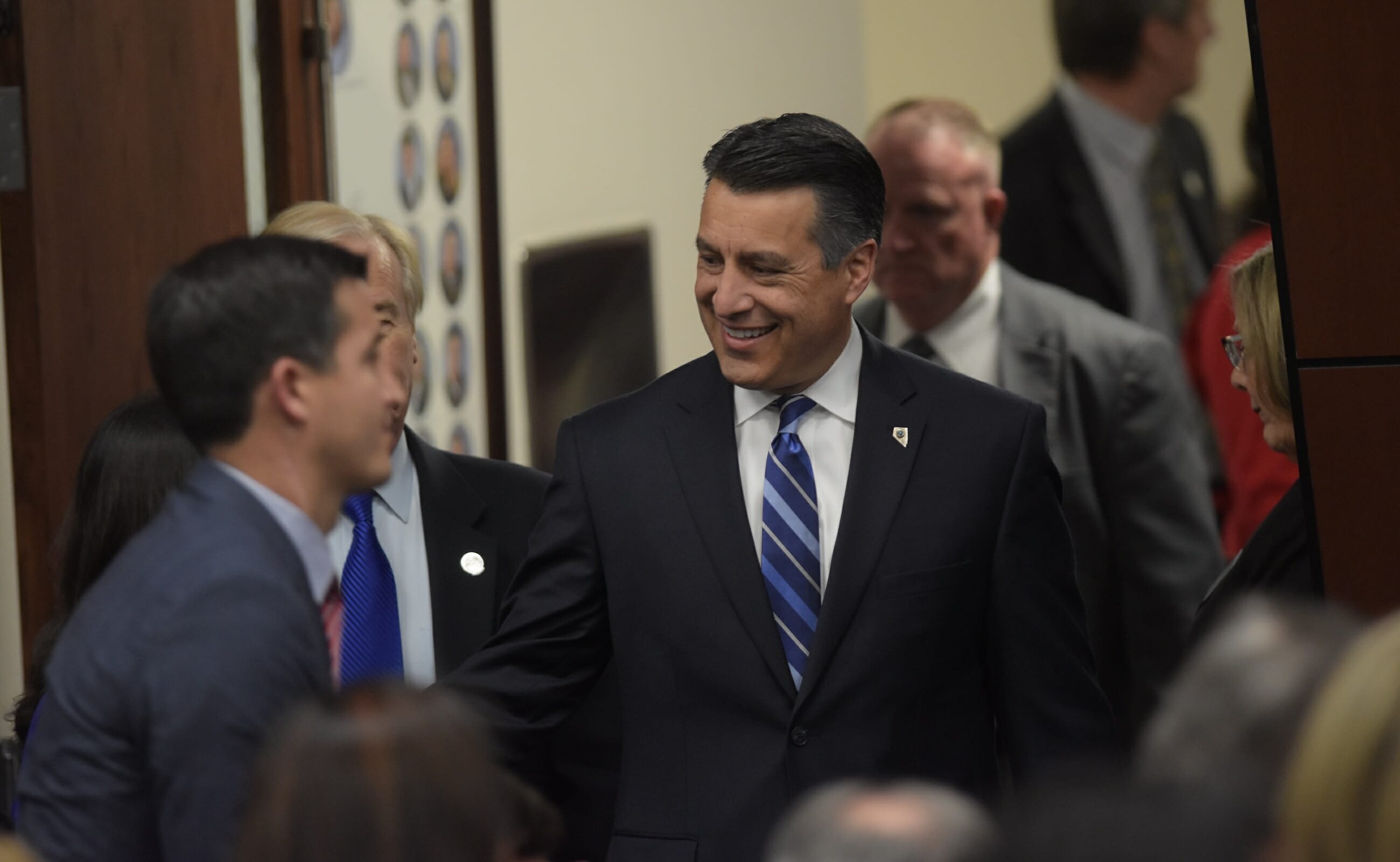
Governor’s Race 2010
The 2010 governor’s race was shaping up as Nevada confronted some of its darkest days. The recession had wracked the state, prompting widespread job losses and a wave of foreclosures.
Republican Gov. Gibbons, who was elected in spite of a late-campaign accusation that he sexually assaulted a woman, later allegations that he had affairs, and a divorce so public and messy that he sought an order forcing his wife Dawn out of the Governor’s Mansion. Gibbons denied the allegations of affairs and assault. The press also raised questions about his work ethic, and his approval ratings dipped into the 20s.
The fiscal pressures forced the state to wipe out its reserves, prompted legislators to pass a set of taxes that only passed Republican muster on the promise that they would expire in two years and spurred three special sessions to plug massive holes in the budget. Lawmakers locked horns with Gibbons, a staunch conservative who held to a no new taxes pledge, and the clashes led to a record-setting number of vetoes and subsequent veto overrides.
Nevada was at a political crossroads: A state that had voted for Democratic President Barack Obama and accepted help from his economic stimulus was also chafing against longtime Democratic Sen. Harry Reid and buoying a Tea Party darling — Republican Sharron Angle — in a midterm Senate race.
It was in that context that Democratic Clark County Commission Chair Rory Reid, son of the senator, stepped into the race for governor. But what Reid thought would be a referendum on an unpopular, scandal-plagued governor took a turn upon rumors of Sandoval’s interest in the race.
“I got into the race to run against Jim Gibbons. It changed dramatically when all of a sudden he (Sandoval) appeared. My job became insurmountable,” Rory Reid said. “There were all kinds of problems. I was young and ambitious, and I thought I could solve them.”
Republicans, realizing they were in peril of losing the governorship because of Gibbons’ unpopularity, persuaded Sandoval to leave his prestigious lifetime appointment to the federal bench and run another campaign. It was a bold move, especially because Sandoval would be challenging an incumbent fellow Republican.
“He was at the pinnacle of his legal career. He was an Article 3 federal judge. The only way he’s coming off of being a federal judge is impeachment by Congress,” Lt. Gov. Mark Hutchison said in an interview. “He’s got the title, he’s got the accolades, he’s got the recognition. He didn’t leave that to go get the title, accolades and recognition of a governor. He already had that. He left that position as a federal judge to become governor to serve Nevada and serve Nevadans.”
And he had the political winds at his back. Powerful monied interests threw their support behind him, and the Republican Governors Association led by Texas Gov. Rick Perry supported him instead of Gibbons. All of this — coupled with polls that consistently showed Reid behind by double digits — turned the race into a painful slog for the Democrat even though he had been successful at fundraising and sought to project himself as the competent “man with a plan.”
“The hardest part of that whole experience was knowing it wouldn’t end well,” Reid said. “But you can’t say that, you have to keep smiling and be optimistic for your staff and your supporters and volunteers and everyone who has worked so hard for you.”
Reid said the part he enjoyed most about the campaign was the six debates they had — a figure sharply in contrast to the 2018 governor’s race that featured none. Their 2010 matchup even included a spontaneous mini-debate during an event they both attended.
“I was behind, I heard he was going to be at some event so I went and challenged him to come up and debate me right there and then, thinking he'd say no, and he said 'OK,’” Reid said. “I have to hand it to him — he had no reason to debate me. He was ahead in the polls. He could have avoided me or done it once and I respect that he was willing to debate.”
Sandoval vowed during the campaign to visit more than 100 schools and promised a shakeup in Nevada’s bottom-ranking education system. It also included platforms on which he’s since shifted: supporting a law like Arizona’s controversial SB1070 that required police to try to determine a person’s immigration status during a stop, supporting civil unions but not same-sex marriage, opposing Obamacare, and vowing no new taxes.
The latter was a position even Reid took, although he said it troubles him now that he said it.
“Frankly, it was what everybody said I needed to say to win,” Rory Reid said. “I just think that anybody — if I wanted to improve education I was going to have to find new revenue. It was obvious. I denied it with a straight face for a long time.”
Some observers say many Republicans who crossed party lines to support Reid over Angle could not stomach voting for a second Reid. As election results came in, it became clear that the only Reid winning in Nevada would be Harry.
The younger Reid, down but relieved it was over, came out to a party of Democrats and gave a concession speech that reflected wisdom he had as the son of a father who had been in the limelight his entire life.
“It was one of the best speeches I’ve ever given. It was heartfelt. I’m glad I said what I said,” he said. “I asked people to give Brian and his family the opportunity they deserve and I asked them to leave his kids alone so they can have a life and to help him make the state great.”
Sandoval’s victory speech was full of the same gravity-defying optimism that had defined his campaign rhetoric.
“I know that we will succeed for this is our time,” he said. “This is our moment. Nevada's best days are yet to come."
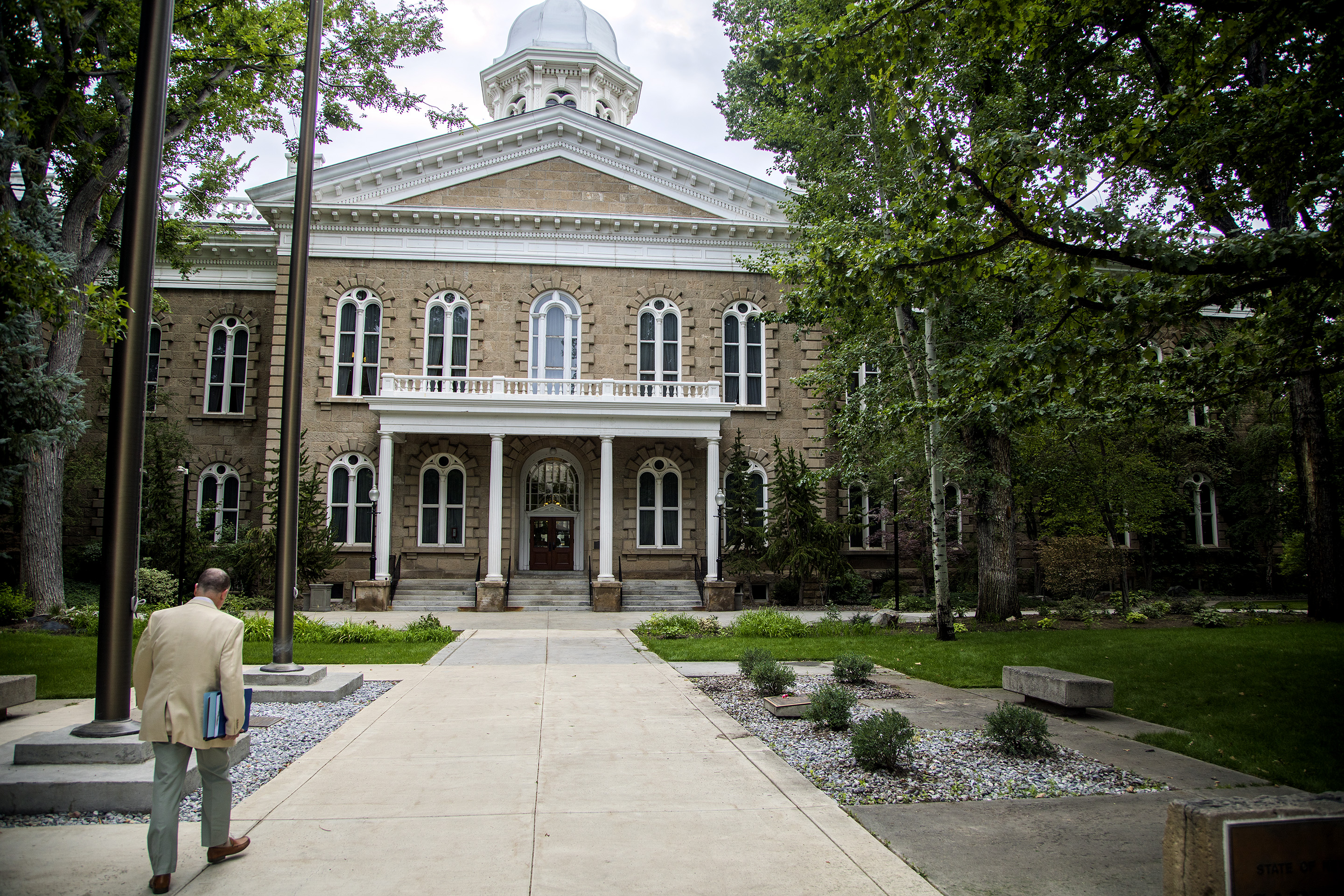
The hard work begins
In the earliest days of the job, everything — even the weather — was forbidding.
Erquiaga recalls that the eve of Sandoval’s inauguration was so frigid, his team was running space heaters in the Capitol. Eventually, the system blew a fuse, just as they were finishing up the inaugural address.
One of the first acts of the Sandoval administration, he said, was waiting up until the electricity was restored.
On the day he was sworn in, Sandoval attended mass at St. Teresa de Avila Catholic Church in Carson City. Las Vegas-based Bishop Joseph Pepe urged him to retain "a closeness to the people we serve. We have to listen and we have to listen carefully," according to the Las Vegas Sun.
Gibbons, his predecessor, didn’t attend the ceremony, citing a previously scheduled medical appointment. Sandoval, meanwhile, urged recession-battered Nevadans not to despair.
“Some would have us believe that Nevada’s best days are behind us – that we must resign ourselves to what we have momentarily become,” Sandoval said in that first address. “We dare not go down that road … If we make the tough choices – the right choices – we will be rewarded with a dramatically different future. I believe this. I believe it can be done. And I am optimistic that Nevada’s best days are yet to come.”
The challenges facing the state were indeed daunting. As the set of temporary taxes passed in 2009 were scheduled to expire, the state was about to lose $450 million in federal stimulus money, and was on the hook for hundreds of millions of dollars to support a growing Medicaid caseload and keep schools afloat as local revenues diminished.
Holding fast to a no-new-taxes stance, his budget used a variety of novel and controversial techniques to sweep money from local government sources, combined with cuts in state services and a proposed 28 percent hike in college tuition to balance the higher education budget.
At one point, some 1,500 college students came to the Capitol grounds to protest the budget and pressure lawmakers to support an ill-fated, Democrat-backed tax hike. They set up tents on the campus, and several dozen of them slept there overnight.
When Sandoval came out to talk with them in the morning, he brought coffee and boxes of donuts.
“A recovering economy is the best thing for the state,” he told them, arguing that it would ultimately generate more money for schools and social services.
“You’re optimistic. We’re not optimistic,” one student said, according to the Las Vegas Sun.
But his disarming style did much to win over his critics, including Democratic then-Senate Majority Leader Steven Horsford — perhaps the lawmaker most outspoken about the cuts in Sandoval’s budget in 2011. While he took dramatic procedural steps at the time to break Republican resolve, including lengthy hearings to put on display the human toll of the cuts, his assessment in a recent interview eight years later is how actively they collaborated to update Nevada’s economic development strategy.
“Gov. Sandoval showed up every day to work. He took his job as governor seriously … He was engaged, he had staff members who were engaged, who were constantly reaching out and talking about what the governor’s priorities were and to listen to what our legislative priorities were,” Horsford said, adding that he felt Sandoval respected the Legislature after serving there himself. “You’re only as effective as your relationship with the legislative branch.”
Sandoval met with all 63 legislators after taking office, according to Governing magazine. That collegiality is a contrast to the 2009 session, when Democratic leaders so deeply distrustful of Gibbons spent months developing a comprehensive alternative budget to the governor’s proposal, then enacted the temporary tax hikes only by overriding a veto from Gibbons.
“Had we followed Gov. Gibbons, this state would have been so far behind, we would still not have recovered,” Horsford said. “That’s why I’m glad that Gov. Sandoval came in as governor when he did. I didn’t always agree with him, I didn’t always support, but I agreed with his overall priorities.”
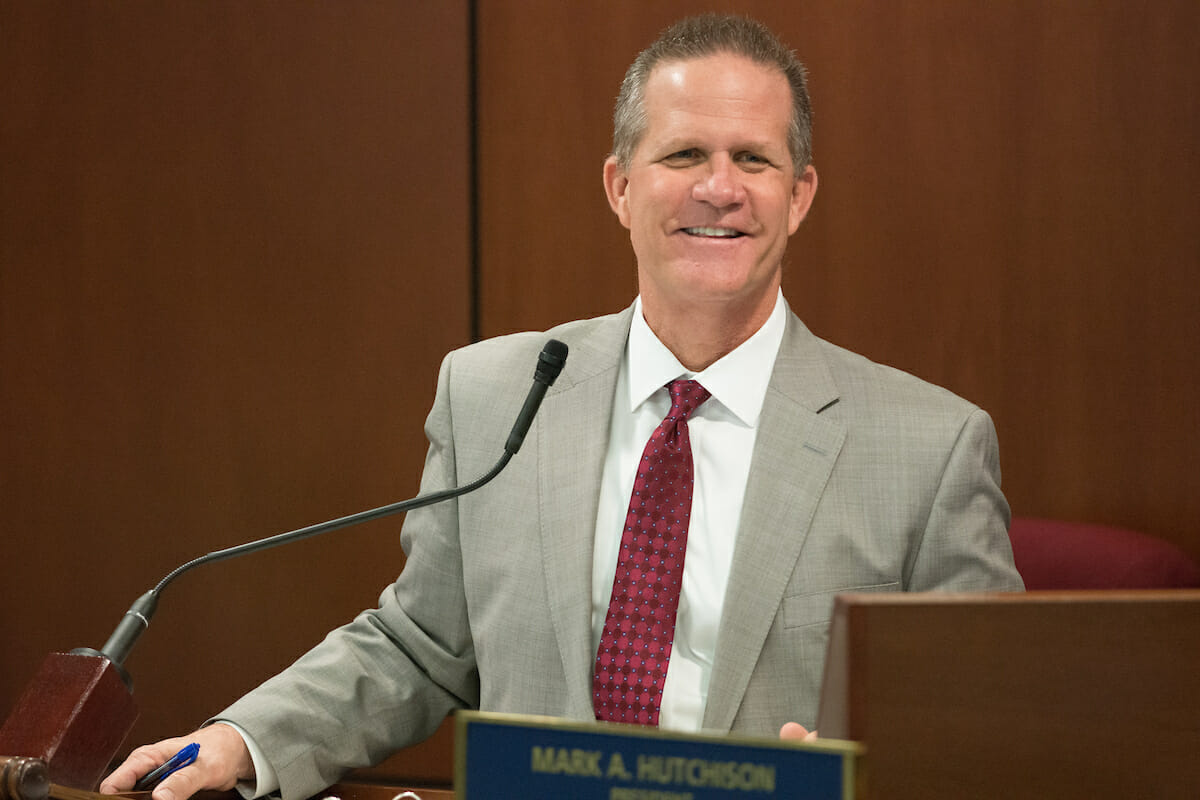
One-on-one
Those who worked closely with him describe Sandoval as detail-oriented and involved in government on an individual level, sometimes directly interacting with people who testify in a public comment period and immediately assigning a state worker to follow up on their issue — a contrast to some officials who appear to view public comment periods as a necessary evil.
Hutchison remembers attending a Labor Day parade with him in Elko a few years back. Shortly after Sandoval’s float reached its destination, one of his staff members told him a woman who watched the parade wanted to talk to him.
The woman was caked in colored powder after just completing a Color Run, Hutchison recalled, and was visibly worked up as she explained the troubles she was having enrolling her child in kindergarten. After venting to the governor, she apologized for being so animated.
“He says, ‘No, this is something you should be worked up about as a mom,’” Hutchison recalled. “‘The education of your children should bring out passion in you.’”
Sandoval then called Erquiaga, his childhood friend and then superintendent of the state, who called the mother and helped resolve the issue. Later in the day, Hutchison said, he reported back to Sandoval that it was fixed.
“Think of how extraordinary that is,” Hutchison said. “His job, he sees it, is to ensure government works for the people of the state of Nevada. It’s not to ignore them, it’s not to blow them off, assign them to somebody who they’ll never hear from. He wants to have somebody follow up, solve their problem and report back to him.”
Hutchison added that Sandoval is an active participant in the numerous boards and commissions he chairs — more than can be said about some members.
“It’s almost embarrassing — there are these boards and commissions where people don’t ask a single question. They don’t make a comment, they don’t make an observation. They won’t do much in terms of input,” Hutchison said. “And the governor’s always 100 percent prepared, fully engaged, driving the direction of that commission.”
Former spokeswoman Mari St. Martin said he was a meticulous editor of statements and speeches and wanted to ensure that his office or a state agency had a voice in stories of state concern.
“He didn’t like seeing ‘unavailable for comment’ or ‘refused to comment.’ He certainly liked something to be said. And it wasn’t even a defense mechanism necessarily, it was just so that there was a presence,” she said. “It was important that people trusted him, and trusted their government.”
As he settled into his role as governor, the hardline 2010 campaign policy stances he took when running a primary against Gibbons melted into something more moderate — the position many had identified him with earlier in his career. In many ways, his later actions in office appear jarring in contrast to his campaign season criticism of Gibbons for approving a budget that included a $200 million tax increase, while pledging to oppose “driver’s licenses for undocumented immigrants.”
In spite of his vocal opposition to Obamacare, he announced in 2012 that he would be the first Republican governor to accept the law’s optional Medicaid expansion.
He never implemented a version of the Arizona immigration law, instead signing bills in 2013 that would allow undocumented immigrants a driver authorization card and implement Zoom Schools to boost resources for English language learners. And he dropped his resistance to same-sex marriage in 2014, abandoning a legal effort that sought to continue defining marriage as between a man and a woman. He now says that he supports marriage equality.
“They deserve to be happy,” he said at a Nevada Independent forum in 2017, adding that his position evolved in part because some of his best friends are gay. “They deserve to have the partner of their choice. It’s where I am on it.”
Brian Krolicki, who served as lieutenant governor during Sandoval’s first term, said the work of governing put Sandoval on a more pragmatic trajectory.
“One of the largest companies, if you will, in Nevada is state government,” Krolicki said. “You’ve got to balance a budget, you’ve got to take care of your employees, you’ve got to take care of your customers. You change gears. There’s a pivot toward administering and away from some of the politics because sometimes you just can’t afford the politics.”
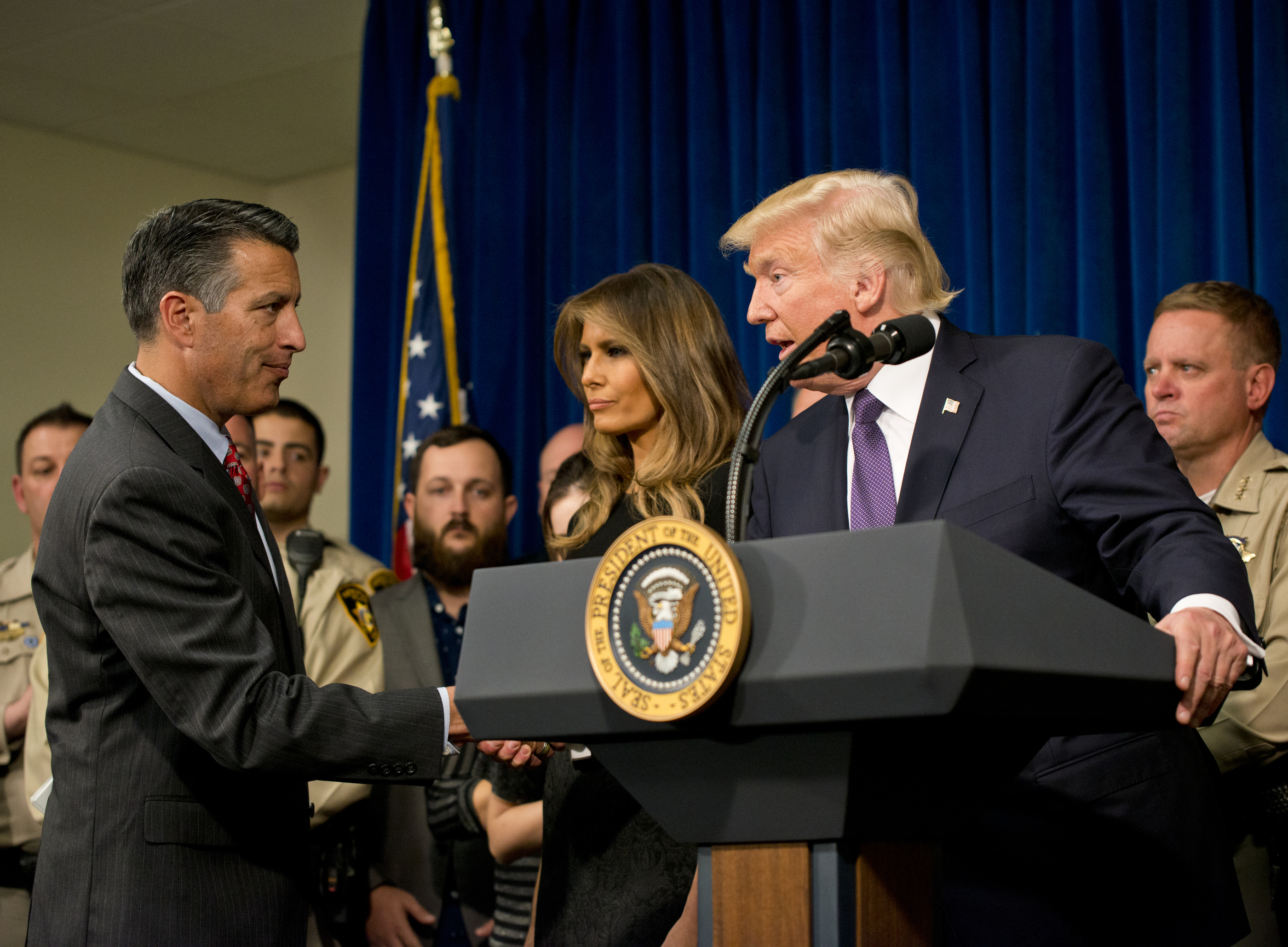
Higher office speculation
As Sandoval’s popularity rose, national observers speculated about when or whether he’d make a break onto the national scene. There was chatter about him being nominated for the U.S. Supreme Court. There was chatter that he would be an attractive candidate for vice president. There was chatter that he’d run for Senate in 2016 to depose Reid.
The rumors that he would leave the governorship were further fanned when Sandoval recruited state Sen. Hutchison to run for lieutenant governor — an affable, upwardly mobile attorney with deep Las Vegas roots who would provide insurance for Republicans if the governor left office.
But he sought re-election, remaining a formidable foe that few Democrats dared challenge. Sen. Harry Reid said he inquired of then-Attorney General Catherine Cortez Masto, but she was set on a future run for U.S. Senate. Other potential competitors, such as former Assembly Speaker Barbara Buckley, Reps. Steven Horsford and Dina Titus all decided to sit the race out.
Sandoval found himself effectively unopposed in what was already a difficult year for Democrats. In the Democratic primary, voters chose “none of the above” over all other gubernatorial candidates, so the Democratic standard-bearer in the general election was an obscure candidate named Bob Goodman.
Sandoval still kept up a circuit of campaign events that included visits to quaint coffee shops and parades and rural tours, according to Hughes, his campaign manager.
“He didn’t have to. This is a guy who was cruising to a 70-point win,” Hughes said. “And there wasn’t an ‘I’m going to mail it in’ or ‘I just have to show up and wave.’ It was ‘Where are we going? What little things can we do? He felt like it was almost his job just to be out.”
In the general election, Sandoval cruised to victory with 71 percent of the vote. But more surprising was the complete wipeout Republicans scored in seats down the ticket, including taking the Democratic-leaning 4th Congressional District seat from Horsford and seizing control of the Assembly for the first time in decades.
Sandoval was thrilled.
“I think there’s this idea that he’s not a party person, that he’s — the RINO [Republican in Name Only] label. That’s just people that are jealous,” Hughes said. “This guy — he was as excited as anybody in 2014. Could not have been more excited.”
Sandoval worked in 2015 to pass a package of tax extensions and increases in tandem with spending on new education initiatives. He said in a recent interview that he knew all along he’d need to take such a step.
“I think I realized it from Day One,” he said. “Before I entered office I had already visited over 100 schools ... I knew there was a dire need, but we were also in a situation where I simply couldn’t … raise a tax.”
His push for taxes further ingratiated him with Democrats who have long sought more funding for education. But it earned the ire of many in his own party who viewed the move as a reversal of his previous campaign promises and a betrayal after voters overwhelming rejected a different levy — the margins tax — on the 2014 ballot.
Americans for Tax Reform, the anti-tax nonprofit founded by Grover Norquist, said Sandoval’s tax pledge marked a full “flip-flop” from his past position on tax increases. The Nye County Republican Party passed a resolution that “excommunicated” Sandoval and Republican Assemblyman James Oscarson over their support of the tax increase.
Others say it was natural for him to hold loosely to the constrictive pledge, and an important opportunity to make a significant mark on the state.
“You can sort of die with a campaign pledge and allow bad things to happen or you can go back to the public and say right now that’s not going to work,” said Vassiliadis. “This governor and most governors actually do evolve while they’re in office. Until someone actually sits down, sees the budget, sees the obligations the state has… they become different.”
He acknowledged his move toward the middle would complicate his efforts to win Republican primaries in the future.
“I have made some pretty unconventional decisions as the governor and I would get sliced like mincemeat in one of those primary debates,” Sandoval said at a Nevada Independent forum in 2017. “But I’d tell you I’d be loud and proud and stand behind my record regardless.”
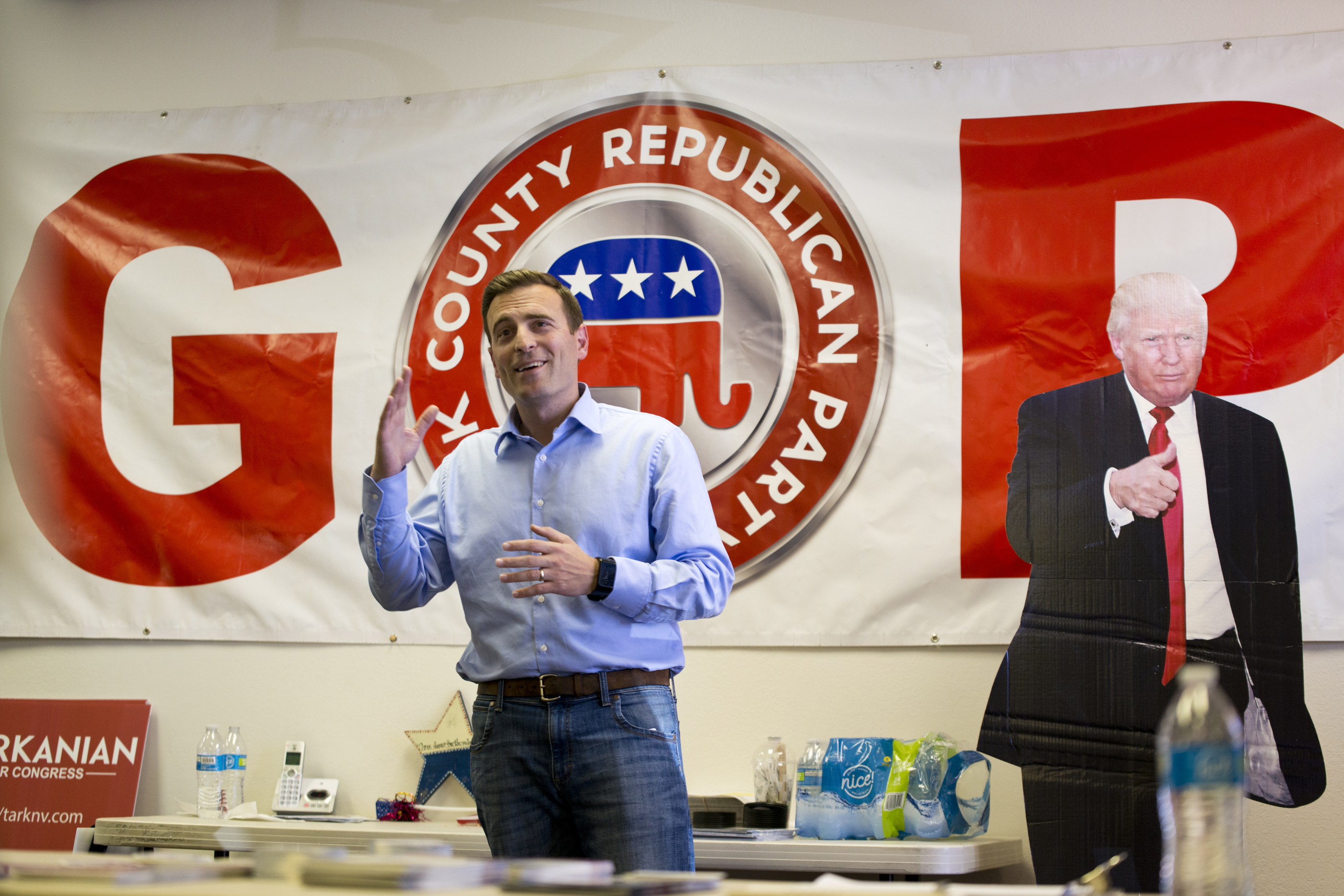
Sandoval the party man
As if the tax package, his decision to expand Medicaid and his eventual disavowal of Donald Trump during the 2016 campaign weren’t enough to earn their distrust, Republicans say he didn’t do enough to build up the party in the lead-up to their blowout in 2018.
Chief among their evidence is that he declined to endorse Republican gubernatorial candidate Adam Laxalt, emphasizing points of disagreement with the attorney general in interviews as the 2018 campaign progressed.
Sandoval had called moderate Republican former Gov. Guinn a mentor, and Krolicki described Guinn as the kind of person who would ask him to meet up for burgers and a talk when Krolicki was treasurer.
But a similar mentor-protege relationship between Sandoval and Laxalt never seemed to take root. Things got off on a bad start when Laxalt — just weeks into holding office — signed on to a lawsuit challenging an expansion of the federal DACA immigration program, which shields young undocumented people brought to the country illegally as children from deportation and allows them to obtain work permits. As with a number of other legal actions Laxalt would take in his term, he did not consult the governor.
Laxalt’s campaign platform also included repealing the Commerce Tax, Sandoval’s most hard-won political accomplishment in 2015, without articulating why it needed to go. And when Laxalt said he wanted to add $500 million more to education, Sandoval poked holes in the goal, publicly questioning whether such a feat was possible given the budget constraints that had already become clear.
Sandoval had said he couldn’t “support a candidate who seeks to undo what we’ve done the past seven years.” He still hasn’t revealed which governor candidate won his vote; he told reporters shortly after the election that he cast it for “one of the candidates” — eliminating, at least, the possibility that he chose the “none of these candidates” option.
Asked about his involvement in party activities, Sandoval told reporter Steve Sebelius in a November interview that while it had indeed been a long time since he attended a Republican state convention, he had raised a lot of money for the party — particularly in 2014 — and endorsed candidates, including cutting commercials for longtime friend U.S. Sen. Dean Heller in 2018.
“I’m a proud Republican and will continue to be a proud Republican as time goes on,” Sandoval said.
While Heller still lost by 5 percentage points in spite of Sandoval’s efforts, Laxalt supporters still wonder what might have been.
"I think that if he would’ve endorsed Adam Laxalt it would’ve made a difference,” said Republican Sen. Joe Hardy. “The question is would it have made enough of a difference in the outcome. It’s kind of look back and think what would’ve happened, but I think there would’ve been probably more ease with people as opposed to questions on the Republican side."
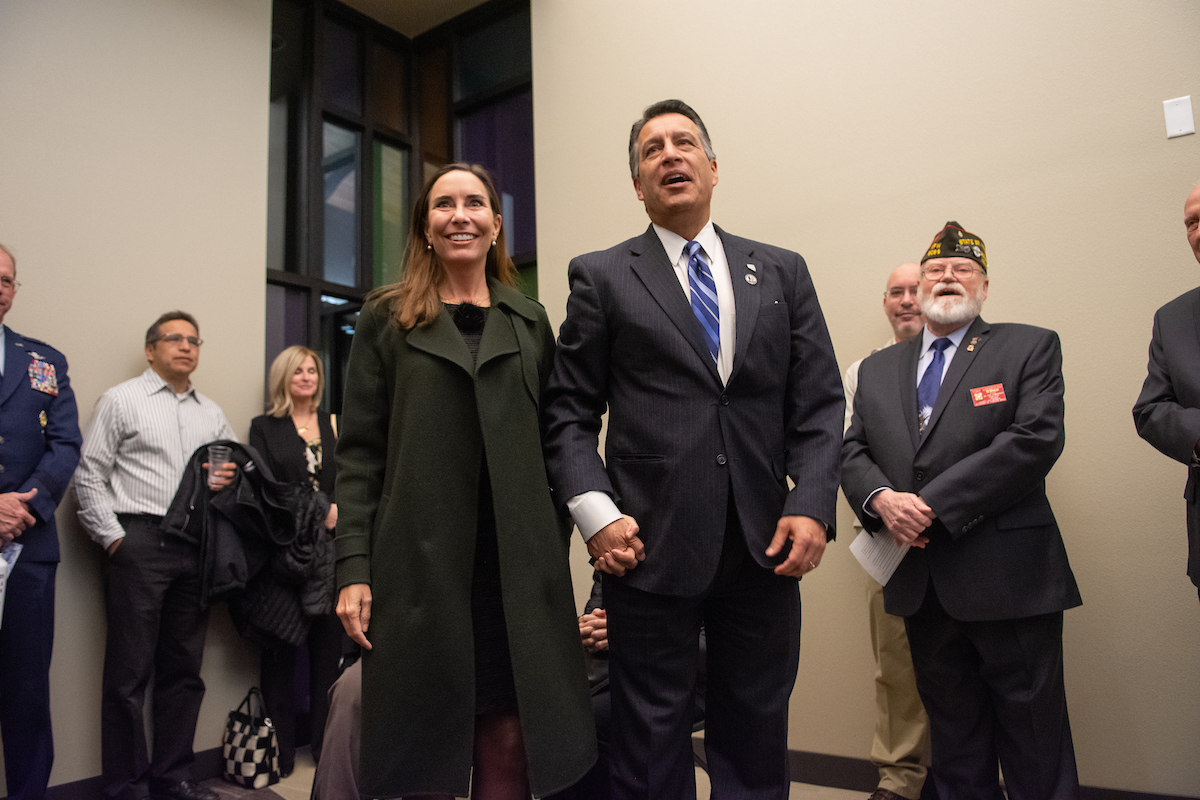
Divorce and remarriage
Sandoval’s popularity and marquee accomplishments in public office haven’t been without a personal toll. His term spanned the teenage and college years of his two oldest children James and Maddy. His 2010 campaign victory came when his youngest daughter, Marisa, had just started first grade; he said she sometimes asked him to leave his security detail outside when he visited her school.
“I’m not going to put words in their mouth, but it is hard on a family. It’s really hard on a family,” he said in an interview. “I’ve loved them and I’m so proud of them because they’ve really had to endure a lot. But at the same time they’ve given me more love and support than I could have ever asked for.”
Just before Christmas in 2017, Sandoval and his wife Kathleen issued a joint statement confirming they were ending their marriage after 27 years. Kathleen, who worked full-time for the nonprofit Children’s Cabinet, had pursued several policy initiatives as first lady, including advocating for sweeping legislation to curb the opioid crisis, implement Breakfast After the Bell at schools, and reform the state’s juvenile justice system. During her husband’s term as chair of the National Governors Association that ended in mid-2017, she led a first lady’s initiative.
“It’s no secret that the demands of public life are hard on a marriage and ours has been affected in a way neither of us had envisioned or expected,” they said.
The divorce was finalized in two months. The court records were sealed, unlike the very public divorce of Sandoval predecessor Gibbons. In a statement, the two said they intended to never discuss it publicly again.
In August, Sandoval married gaming industry executive Lauralyn McCarthy — a fellow UNR graduate originally born in Southern California — in a private Lake Tahoe ceremony. McCarthy, formerly employed with IGT and Scientific Games, is currently an executive with Aristocrat Technologies.
Lauralyn has assumed many of the duties of first lady with gusto, making frequent public appearances and joining Sandoval on trade missions to Japan and Australia.
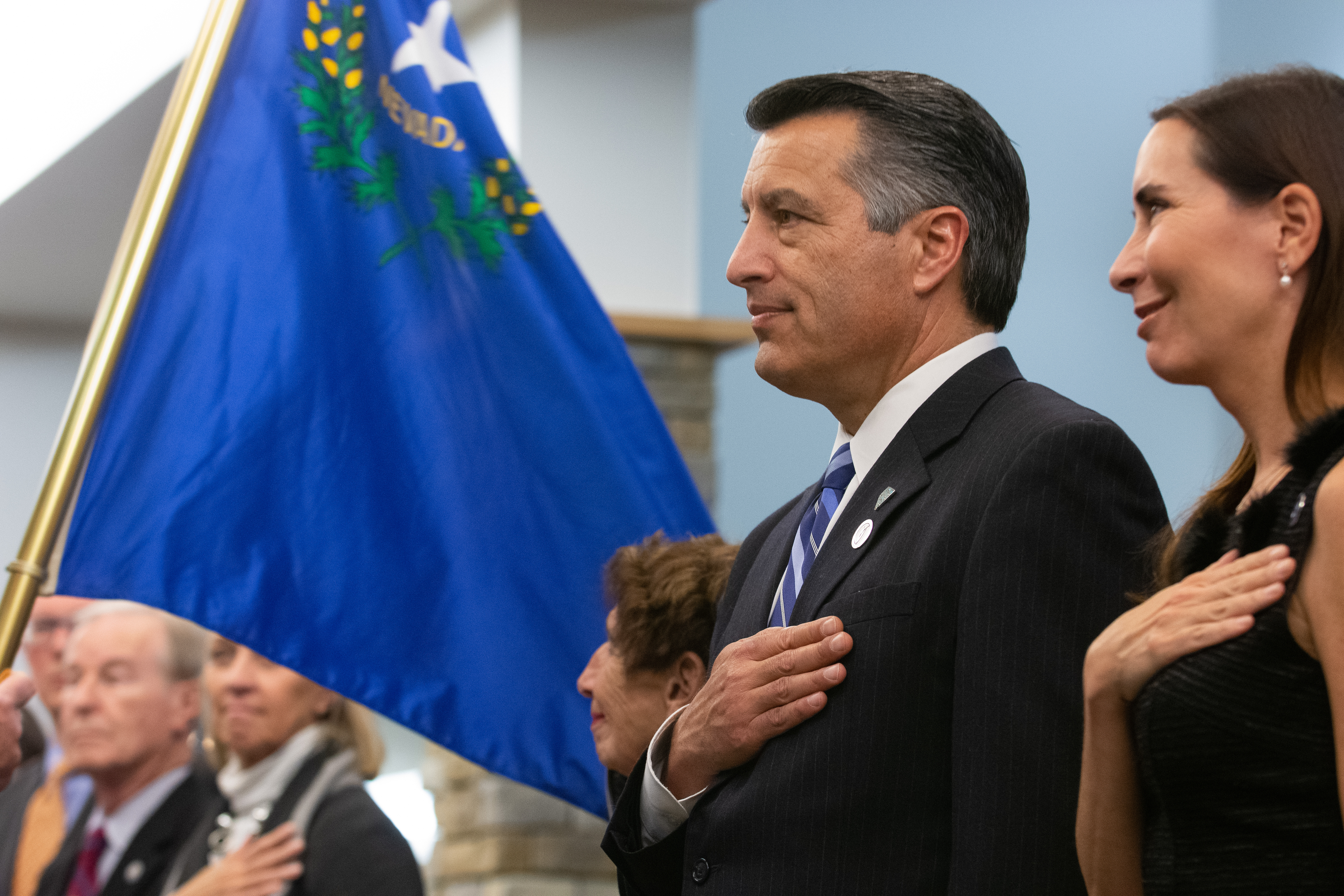
What’s next
Sandoval passes the baton to Democrat Steve Sisolak on Monday, but what lies beyond is still mostly unclear. His brother is looking forward to him spending more time with extended family. Harry Reid says it will be an opportunity to make money after so many years in the public sector. Horsford foresees another chapter in public service that’s yet unwritten.
What is sure: His next step includes a part-time job helping launch a new program at UNLV’s Boyd School of Law called the Law and Leadership class. It’s modeled after a similar program he attends at Ohio State each year.
“Essentially it will bring my experience having served in all three branches of government, as a legislator, as a regulator, as a federal judge, as governor, as attorney general, as a member of the [Tahoe Regional Planning Agency] and hopefully teaching those students that intersection of law and policy and politics,” he said.
But on that cold December evening at the freshly painted veterans home, he stood and delivered remarks in front of a cozy fireplace and near the building’s built-in sports bar that will someday soon serve residents and their friends as they swap jokes and war stories. Unlike most in the audience, he didn’t have a cap embroidered with the name of a military branch or war, his dream of following his father into the service unrealized.
As a law student, he had set his heart on joining the Judge Advocate General (JAG) program, going as far as to schedule a physical the summer before his final year in law school.
Word got around, and Sandoval said the firm’s partners made a “really generous offer” if he would stay put. He cancelled the physical. A few years later when he sought to enlist in the Navy Reserves, they told him he was too old to join.
“It’s probably my biggest regret in life,” he said about not joining the military. “And that was part of the impetus for running for governor and federal judge is I didn’t want to have another regret in life like that.”
What he could share with the audience was his thanks for their service, that he wanted Nevada to be the most veteran-friendly state in the union. Beyond funding the veterans home years ahead of schedule, he’d helped clear barriers for service members to attend college, attended every deployment ceremony involving Nevada National Guard members, and built memorials to their service on state facilities in Las Vegas and Reno.
“When you look at it, it's really about public service. And whether you wear a uniform to be a public servant or you wear a suit, it doesn't really matter, it's still public service,” Adjutant General William Burks, head of the Nevada National Guard, said about Sandoval before the ribbon-cutting. “He'll continue to be a public servant his whole life, somehow. There's no doubt in my mind.”
Megan Messerly and Riley Snyder contributed to this report.